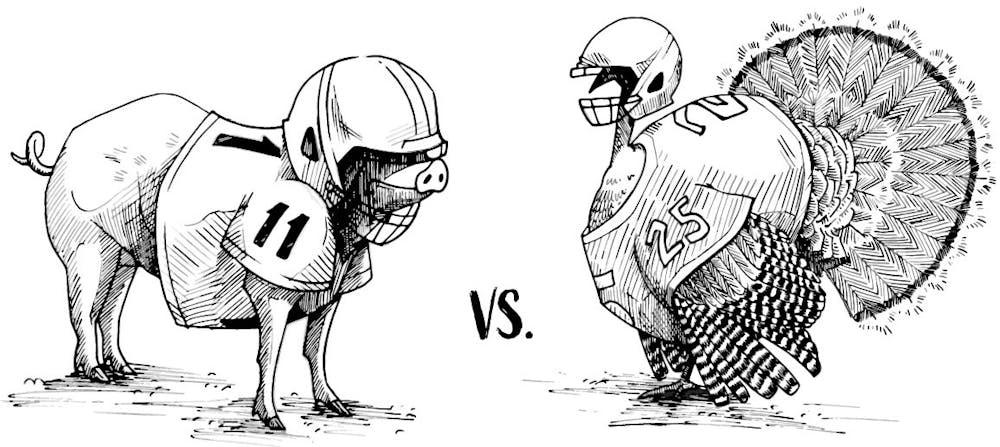Thanksgiving: a holiday marked by the practice of giving thanks and the presence of turkey… or is it ham?
An article recently published by The Washington Post revealed that Americans consume around 46 million turkeys and 24.75 million pounds of bone-in ham each Thanksgiving — statistics that highlight the popularity of both entrées.
Tradition may favor the turkey, but ham remains in demand. This growing tension has given rise to the great Thanksgiving debate: Team Turkey or Team Ham?
Both may be valid options, but which Thanksgiving centerpiece is superior?
While taste should be a consideration when choosing between the two, nutritional impact should also be given a voice in the conversation.
An article recently posted on Foodstruct, a nutrition comparison and search site, reveals that turkey is richer in vitamins, protein, phosphorus, copper and magnesium.
However, turkey is also higher in fat and cholesterol than its counterpart. Ham is richer in zinc, potassium and iron — but contains significantly higher amounts of sodium. To simplify the argument, turkey is a fresh white meat while ham is a cured processed meat. This means that ham contains greater levels of both sodium and nitrate, which can negatively impact the consumer’s overall health more significantly than turkey.
Of course, the health effects of your Thanksgiving turkey or ham stem in part from the manner in which you cook your meat. In light of this, be mindful when preparing your food of the impact that will have on your health.
Regardless of how it is prepared, turkey remains the healthier meat.
Team Turkey: 1. Team Ham: 0
When choosing your Thanksgiving entree, also take into consideration the ethical treatment of the animals in question. Although most pigs and turkeys are raised with the end goal of consumption, the humane care of those animals should be a concern regardless.
Unfortunately, neither the pork industry nor the poultry industry has positive reputations when the issue of ethics is raised. The overwhelming majority of both pigs and turkeys in the U.S. are raised on factory farms known as Concentrated Animal Feeding Operations (CAFO) — farms which are infamous for the conditions in which they raise and care for the animals in their charge.
Foodprint, a resource designed to support ethical food choices, states that the majority of turkey CAFOs keep their birds in overpopulated sheds with no access to the outdoors. The turkeys’ beaks are clipped and the conditions in the CAFOs make them far more susceptible to disease. Comparatively, hogs are raised by thousands in climate-controlled barns next to piles of their own feces. Research has proven that pigs, shown to be intelligent and social animals, sustain cognitive impairment in these conditions — becoming stressed and aggressive when restricted from their natural environments and behaviors.
While there may seem to be no clear winner (or loser) in this conversation, turkeys suffer one more blow.
In recent years, the demand for lean white meat has led to selective breeding among poultry. This pressure to produce specific types of turkeys has led to the extinction of what are now called “heritage breeds.” This in turn has led to a loss of biodiversity that makes future turkeys more susceptible to disease.
Turkeys are now at greater risk, and so, from the viewpoint of the entrées in question:
Team Turkey: 1. Team Ham: 1
Taste and treatment aside, which is the kindest cut in relation to the environment? In other words, what “foodprint” does each centerpiece leave?
An article from 2015, entitled “The top 10 foods with the biggest environmental footprint” highlights foods that produce the greatest greenhouse gas emissions per kilogram of food. Pork, number four on the list, emits 12.1 kg of CO2. More than half of these emissions originate from the intensive farm operations needed to raise the pigs. The rest of these carbon emissions stem from processing, transporting and cooking the meat at home.
Turkey, number six on the list, emits 10.9 kg of CO2 — most of which stems from feed production, processing and home cooking. Not much room for error there — turkey takes the cake when it comes to carbon footprints.
Team Turkey: 2. Team Ham: 1
Though there are certainly pros and cons to both, turkey seems to be the better meat by a fraction.
Nevertheless, this is not an attempt to condemn or uphold your family traditions. Rather, it is a challenge: this November, consider the impact your Thanksgiving meal could have on both your health and the well-being of the creation we’ve been called to steward.
Whatever you buy, buy ethically. Source your foods locally, supporting small businesses and buying pasture-raised poultry and pork. Plan to prepare your food in a manner that is mindful of the health and welfare of every person around your table.
And if you can’t decide whether turkey or ham is a better fit for you? Don’t be afraid to buy tofu.




